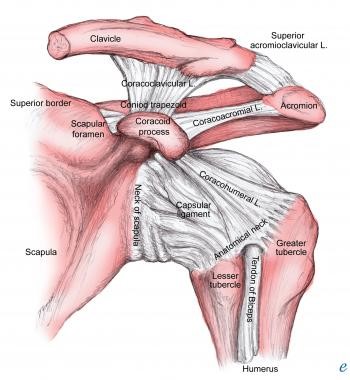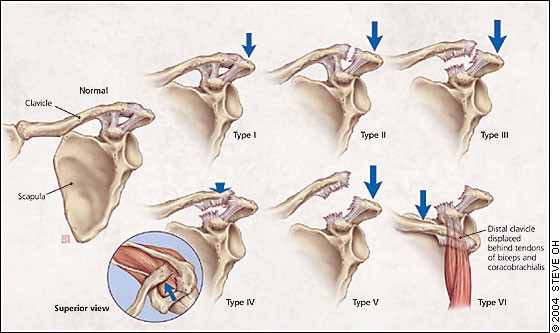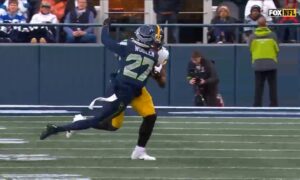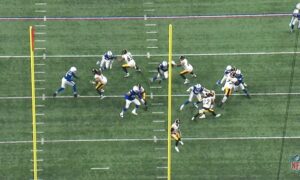If you’re a Pittsburgh Steelers fan and you haven’t been in a coma, you know what a big deal the Sunday Night Football matchup is, as the Steelers battle the Buffalo Bills in their home finale for playoff position and a Wildcard spot. Already missing starting QB Ben Roethlisberger and WR1 JuJu Smith-Schuster, the team would really benefit by the return of RB1 James Conner, who has been sidelined by injury for weeks.
Adam Schefter shared good news for Pittsburgh fans just now:
After a full week of practice, it looks like James Conner is ready to rock and roll. But we thought the same thing when he returned in the first game against the Browns, only to leave the game early after reaggravating his shoulder injury. He sounded fairly noncommittal a week ago during his radio segment with Andrew Fillipponi and Chris Mueller a day after the Cardinals game (the 3rd in a row that he missed and wasn’t able to make the trip to Arizona). So is he really ready? And how risky is it for him to play tonight?
First, a quick refresher on AC sprains: An AC sprain is often seen in contact sports. A football tackle, where the player lands on his shoulder, is the typical mechanism, which is what happened during the MNF game against the Miami Dolphins. It didn’t look that bad, and both Dr. David Chao (@profootballdoc) and I thought it was going to be a mild AC sprain.
So what exactly is an AC sprain? The shoulder joint is made by the junction of three bones: the collarbone (clavicle), the shoulder blade (scapula), and the upper arm bone (humerus). The scapula has a bony process called the acromion, which is attached to the end of the clavicle by several ligaments. The joint between this part of the scapula and clavicle is called the acromioclavicular (AC) joint. The rounded end of the humerus sits in this joint like a ball in a socket.
If the ligaments of the AC joint are stretched or torn, the shoulder may not function normally. The most common symptoms are pain, swelling, and decreased range of motion in the shoulder. AC sprains are graded according to the Rockwood scale from 1-6:
The treatment for a type I or II injury includes a sling, ice, anti-inflammatories, and sometimes physiotherapy. The pain usually improves quickly, but the ligament can take up to 6 weeks to heal completely. With a type 1 AC sprain, the risk of early return is usually the risk for increased pain but not worsening the injury. With a type 2 sprain, the ligament needs to heal more before the player returns in order to have stability in the joint. Based on comments Conner made the week before his initial return, I would guess he had a type II sprain. He talked about needing stability in his shoulder before he could do everything he needed to do in order to play at a high level.
Let’s see what the experts say about AC sprains. In a study on AC joint injuries in the NFL from 2000 to 2011, this is what the authors found:
- Of 2486 shoulder injuries, 29.2% of shoulder injuries involved the AC joint.
- Of the 727 AC joints evaluated, 210 were type 1, 40 were type 2, 66 were type 3 (another 319 were listed as unspecified). No injuries worse than type 3 were reported.
- 2% of AC joint injuries were sustained by RBs. The position most likely to get an AC joint injury was defensive back (16.1%), followed by wide receiver and special teams player.
- In terms of incidence by position, RBs were not as likely to get an AC joint injury (11.5 per 100 players) as QB, ST, WR, and TE.
- RBs missed an average of 11 days (this includes all types/severity)
- All players with a type I AC joint injury missed an average of 7.3 days.
- All players with a type 2 AC joint injury missed an average of 10.3 days.
- All players with a type 3 AC joint injury missed an average of 26.4 days.
- Only 1.7% of these injuries required surgery.
- Players who underwent surgical management lost a mean of 56.2 days.
Speculation time. I think that Conner originally had a type 2 AC sprain, which was healing well. When he got hit in the Browns game and aggravated his injury, it may have worsened to a type 3. He himself said that surgery may be necessary, and type 1 and 2 injuries are never treated surgically.
So let’s assume that after the Browns game, Conner had a type 3 AC sprain based on that. The treatment for type 3 sprains is controversial based on the medical data. There are studies supporting surgical treatment for all sprains type 3 or worse and other studies supporting conservative (non-operative) management. I think the trainers and team doctors were trying to avoid surgery, but it’s likely that the timing was a factor as well. This late in the season, surgery would mean that Conner was done for the year. And with the Steelers eyeing a Wildcard playoff berth, the chance to let Conner get healthy and return was a deciding factor.
So, after a week of practice and no setbacks, it looks like Conner will get a helmet tonight. What is his risk for reinjury? Leclere et al reviewed medical records from 1980 to 2008 for a single NFL team. They found the following:
- 328 players included in the study started their career on this team and remained on the roster for at least 2 years.
- 31 players had a history of instability prior to entering the NFL.
- Of the 297 players with no prior history, 31 had a shoulder injury while on this team.
- The patients treated nonoperatively had a significantly higher rate of recurrence (P= 0.02) and an earlier time of recurrence (P = 0.04).
- Between the 2 groups (prior vs no prior injury), there was no difference in the rate of recurrence.
- Five of these players (41.7%) had recurrent instability at a mean of 4.4 ± 7.0 months (range, 0-16 months).
So based on this, Conner does have an increased risk for reinjury tonight…but that probably wouldn’t be different in any game for the rest of the season, or the postseason if the Steelers can punch their ticket. Tonight’s game against the Bills is a big one and my determine whether the Steelers play in January. Since it probably doesn’t change Conner’s longterm situation, he may as well play if he is able to go.










